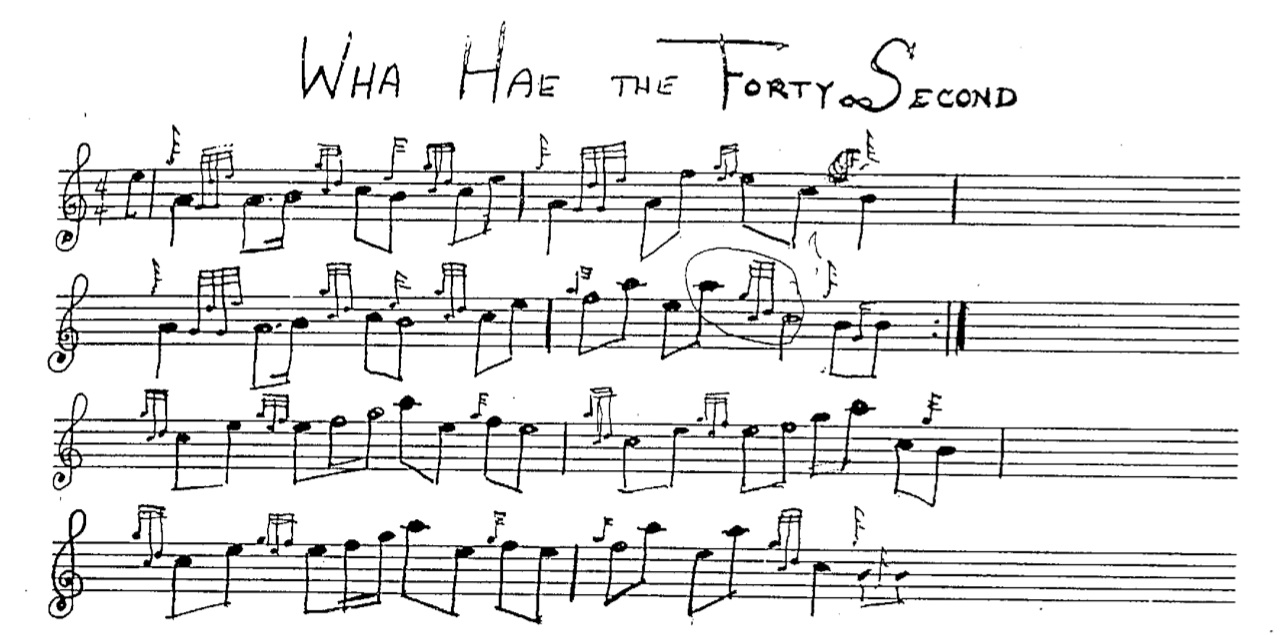We’ll do our first try at telling the story behind a song, hopefully you find it interesting.
Wha Hae the 42nd
Our first tune is the first tune in the 42nd’s “first set“. We know it as “Wha Hae the 42nd”, but you’ll hear titles with many variations on that – including “Wha Saw the 42nd“, “Saw ye the 42nd”, “The 42nd March”, or just “The 42nd“.
Here is the version that we play today:
Of course, there are lyrics:
Saw ye the Forty-Second? Saw ye them gaun awa'? Saw ye the Forty-Second Marching to the Broomielaw? Some o' them had boots an' stockin's, Some o' them had nane ava; Some o' them had tartan plaidies, Marching to the BroomielawWith many more verses.. See traditionalmusic.co.uk for all the lyrics.
Wonder what the “Broomielaw” is? (It’s the dock in Glasgow harbor from which troopships often sailed.) See here for a discussion on the song’s lyrics, and some help with some of the Scots words you might not recognize.
David Murray’s “Music of the Scottish Regiments” indicates that the song might refer to the irregular dress of replacement troops, made up of reservists and volunteers who had little notice before having to embark for overseas. Thus there was little time to equip or uniform them prior to marching to the troopships. Murray says the Black Watch absorbed the tune and played “Wha saw the 42nd” when leaving a station; it was played when the regiment departed for the Korean War in 1953 (Fiddler’s Companion).
A discussion in the Mudcat Cafe suggests some of the verses date to around the Crimean War (1850s), or even (in the case of the “tattie hawkers”), before.
Wha Widna Fecht for Charlie
The words to “Wha Hae the 42nd” share the melody with “Wha Widna Fecht for Charlie”, which despite its Jacobite-sounding title and lyrics (warning – the link plays music), Murray notes that its origins are actually from the India campaign in 1842.
“Widna Fecht for Charlie” is the regimental quick march of the 22nd (Cheshire) regiment- and Murray believes it commemerates Sir Charles Napier’s leadership of the Cheshires in the 1842 conquest of the province Scinde. This is corroborated in Oscar George Theodore Sonneck’s “Musical Quarterly, Volume 4” (October 1918), and in “United Service – A Monthly Review of Miltary and Naval Affairs, Vol 5” (1891). Anybody have any knowledge about this? My copy of “Music of the Scottish Regiments“ hasn’t arrived yet…
The tune first appeared in print in Howe’s “1000 Jigs and Reels” (1867 -p. 126)
Will You Go and Marry Ketty
Naturally, “Wha Widna Fecht for Charlie” isn’t the original title of the melody in question. Its unknown author adapted it from an older tune, “Will You Go and Marry Ketty” (Or Katie, or Kitty), which first appeared in Neil Stewart’s “Collection of the Newest and Best Reels or Country Dances” (1761).
And So On
The Fiddler’s Companion notes that “Wha Widna Fecht for Charlie” is sometimes the accompaniment for the Seann Truibhas. And to my ear, “Whistle O’er the Lave O’t” has more than a passing resemblance to the tune. Some pipers have suspected that the (modern) bagpipe favorite “Scotland the Brave” may be influenced by this old song, as well.
Hope this article was informative, or at least interesting!





Well done, lads…good to see the history being not just taught but diseminated…see you next Season at Ouiatenon!
42nd Alumni, 1980-85